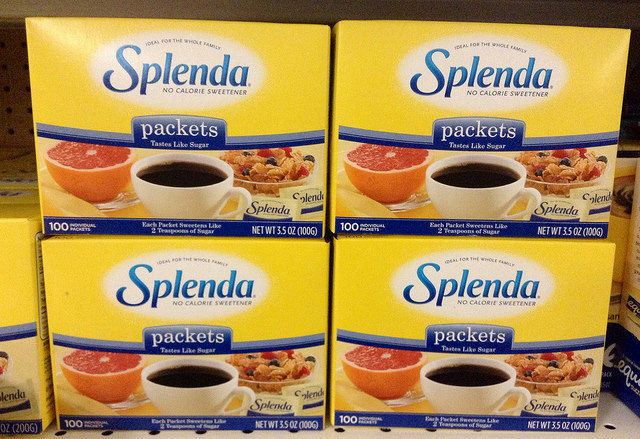
In which a non-scientist (me) asks questions about the reporting of a scientific study and reassures himself — through the twin powers of “reading what other scientists think” and “doing math” — that he’s probably not going to get blood cancer from Splenda. At least, not immediately.
***
So here I am the other day, writing a post while consuming a significant amount of coffee sweetened with an insignificant amount of sucralose — that’s the sweetener in Splenda, or, if you like, the yellow packets (pink is saccharin, and blue is aspartame, and I think these days you can also get green, which is stevia, but I digress) — so here I am drinking coffee and typing away when I see that on Facebook’s little trending list is the word “Splenda,” and I think “oh, boy, here we go.”
The link took me to this article over at MSN’s “Health & Fitness” section, an article called “A Scary New Reason To Avoid Splenda.” The article in question says that a new study shows that mice dosed with large amounts of sucralose developed certain kinds of cancers. This is technically true, but as always, the devil’s in the details.
The abstract says they added sucralose to the mice’s feed at rates of 0, 500, 2000, 8000, and 16000 parts per million, but it’s a little hard to nail down exactly how much sucralose they were taking in per day because the study says they were fed “ad libitum,” meaning they could eat as much or as little as they liked. According to Emily Willingham at Forbes, when they contacted the authors of the study, they said it was equivalent to 60mg/kg/day, which makes sense because lab mice apparently eat roughly 10g-15g of food per 100g of bodyweight per day: so (if my math is correct, anyway) at 500ppm, the low end the mice would be 50mg/kg/day, and at the high it’d be more like 75mg/kg/day.
Amounts are important, because as we all know, the dose makes the poison.
The FDA has set the ADI (acceptable daily intake) of sucralose at 5mg/kg of bodyweight. Since Splenda is apparently only 1.1% sucralose, that means in a 1g packet, that’s 0.011g or 11mg of sucralose. According to the FDA guidelines, then, I should be perfectly safe consuming 5mg/kg/day, which, in a 65kg person such as myself, amounts to 325mg/day, or, with just 11mg in a 1g packet of Splenda, 29.5 packets per day.
But the No Observed Adverse Effect Level (NOAEL) of sucralose is a hundred times higher, more like 500mg/kg/day (2905 packets a day for someone like me), so the FDA is really advising on the safe side.
The study’s highest dose is 32 times higher than its lowest dose, at around 1920mg/kg/day (based on the idea that 500ppm = 60mg/kg), so I suppose it would be unsurprising to find that it’s bad for you, since it’s nearly four times the level at which no adverse effects are seen.
So just to recap: the FDA’s acceptable daily intake amount is 29.5 packets a day for someone my weight (65kg). The lowest amount tested in the study is 60mg/kg or 354.5 packets a day, and the highest amount in the study was 1920mg/kg, or 11,344 packets a day.
But while the study’s lowest dosage has a dosage to weight ratio roughly an order of magnitude higher than the FDA’s ADI, it’s also an order of magnitude lower than the NOAEL, so that would be a result, even if not one that you should be immediately terrified by unless you consume a stupid amount of Splenda.
But the study (and its authors) have a few more issues than the usual. According, again, to Emily Willingham at Forbes, the study’s data actually show a dose-response decrease in cancers in the female mice, no change across the board in all mice, and a weird dip in cancer at 8000ppm (5670 packet/day-equivalent):
- Their results show a dose-related decrease in cancerous tumors in female mice, from 67% in females exposed to no sucralose to 59.4% in female mice exposed to 16,000 ppm. At 8,000 ppm, the decrease is even steeper, down to 55.4%. The increase in males from 0 ppm to 16,000 was from 56.4% to 62.9%, but at 8,000 ppm, the rate was 53% in males, 10% lower than the zero exposure level.
- The same pattern of decrease is evident for females and blood cancers–sucralose-stuffed female Swiss mice had half the cancer rate with 16,ooo ppm sucralose vs. no sucralose.
- For the entire mouse population, males and females combined, cancer rates were practically identical across doses; at 0, 500, 2,000, 8,000 and 16,000, rates for the whole mouse population were 61.6%, 61.6%, 60.7%, 54.2% and 61.2%, respectively
As she writes, it’s all very “messy,” and it really sounds like noise rather than results. Additionally, this study comes out of something called the Ramazzini Institute, whose reputation is not one for sound scientific practice, especially where claims about sweeteners are concerned.
I wouldn’t advise tossing the study away as complete garbage or anything, but given the numbers involved, the truly ambiguous results, and the known dangers of consuming an equivalent quantity of sugar daily (remembering, of course, that one 1g packet of Splenda sweetens as much as twice that amount of table sugar), I’m going to stick with a little Splenda in my daily coffee after all.
Check out Willingham’s article for more, and thanks to everyone over at r/skeptic as well.
***
Richard Ford Burley is a human, writer, and doctoral candidate at Boston College, as well as an editor at Ledger, the first academic journal devoted to Bitcoin and other cryptocurrencies. In his spare time he writes about science, skepticism, feminism, and futurism here at This Week In Tomorrow.
